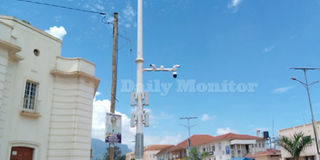Prime
President Museveni's 11-point security measures: What is the status?

A CCTV camera installed on Republic Street in Mbale City. PHOTO/PHOEBE MASONGOLE
What you need to know:
- Following the assassination attempt on Gen Katumba Wamala that left his daughter and driver dead, we track the implementation of the key security measures the President highlighted.
In 2018, President Museveni issued a number of security measures, which he said, would end wave of killings in the country.
Prior to the announcement, a number of high profile people had been killed, including Ibrahim Abiriga, the former Arua Municipality MP, AIGP Andrew Felix Kaweesi, the former police spokesperson; former senior prosecutor Joan Kagezi and Major Muhammad Kiggundu, among others.
The measures included deployment of Local Defence Unit personnel, installation of CCTV cameras, use of drones, gun finger printing, ban on hoods for cyclists, use of electronic number plates for cars and motorcycles, cleaning of Uganda Police of former criminals, public intelligence and use of police radio calls, among others.
Following the assassination attempt on Gen Katumba Wamala that left his daughter and driver dead, we track the implementation of the key security measures the President highlighted.
CCTV cameras
Government started the installation of the security cameras in April 2019, close to a year after the announcement of the security measures. Since then about 3,200 cameras have been installed across Kampala Metropolitan area, covering Kampala, Wakiso and Mukono. CCTV control centres have been established in the 18 policing divisions under Kampala Metropolitan area. Across the country, the cameras are being installed in cities and other major towns and highways.
Gun finger printing
Records from police indicate that more than 60,000 guns have been registered across the country by the gun finger printing committee. These include guns from Uganda Police, Uganda Prisons, Private Security Organisations and individuals.
LDUs deployment
The Uganda People’s Defence Forces moved to recruit 13,000 Local Defence Unit (LDUs) personnel. By the end of last year, more than 10,000 had been recruited. However, security forces came under intense scrutiny when the LDUs turned their guns on innocent people, killing them at will without facing the law. UPDF has since announced that it will phase out the LDUs.
Drones
While President Museveni promised to introduce use of drones to monitor security across the country, government has not started deploying them in any part of the country.
Electronic number plates
The President said government would introduce electronic number plates for both cars and motorcycles. This has not commenced.
Ban on wearing hoods by cyclists
The directive was enforced for few days after the death of Abiriga, but eventually cyclists went back to using hoods.
Cleaning the police
The President promised to rid police of criminals whom he said had infiltrated the Force. After sacking Gen Kale Kayihura in March 2018, Mr Museveni appointed Martins Okoth-Ochola the IGP and Maj Gen Sabiiti Muzeyi as his deputy. Later on, he replaced Gen Sabiiti with Maj Paul Lokech and a number of soldiers have since been appointed as commanders in the police force. The cleaning process is ongoing.
Sharp shooters to protect VIPs
A number of VIPs were assigned the sharpshooters from the Uganda People’s Defence Forces (UPDF) to guard them from criminals.
Use of police radio calls
The status has remained unknown
Public intelligence
A number of plain clothed intelligence officers have been seen working alongside security forces during protests. Inside sources say some cyclists and other people have been enlisted as spies to track and follow suspected criminals and detect crime in and outside the country.
Regulation of social media
Government introduced OTT tax and banned the social media sites such as Facebook. Police also set up media monitoring units specifically to target critical voices on social media.



